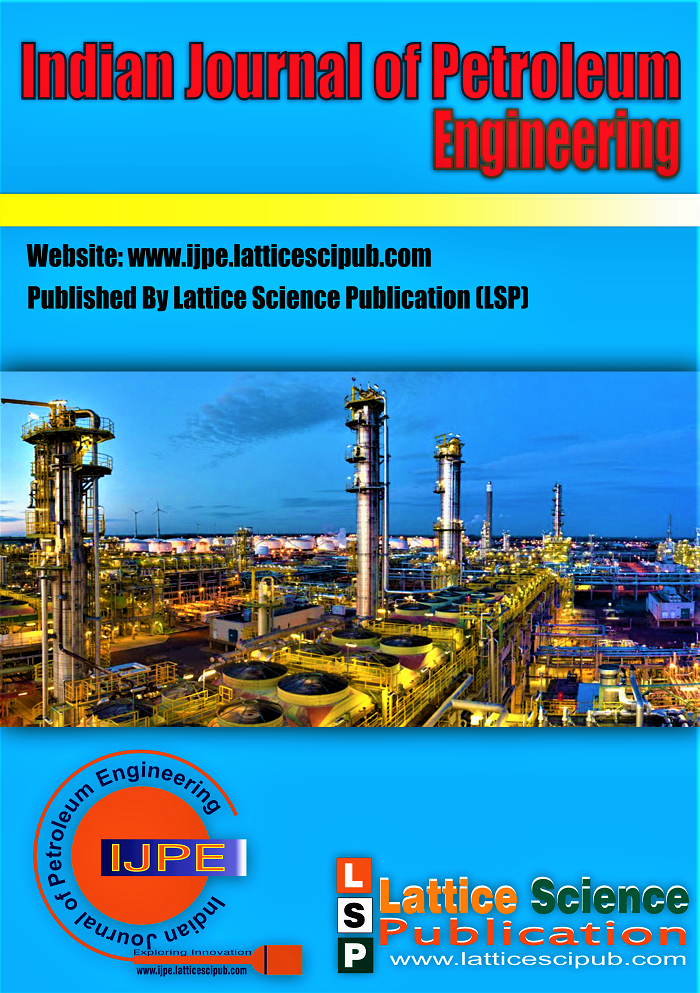Optimal Productivity Index from Gas Pay Zones with FAF Test
Main Article Content
Abstract
Gas Condensate reservoirs are hydrocarbon liquid dissolved in saturated natural gas that comes out of solution when the pressure drops below the dew point. Condensate liquid saturation can build up near a well because of draw down below the dew point pressure, ultimately restricting the flow of gas. This phenomenon is called as “condensate blockage or banking”. This improves the mobility of the gas with respect to the oil. If the gas does not have sufficient energy to carry the liquid to surface, then “liquid loading” in the wellbore occurs. If liquid falls back down the wellbore, the liquid percentage will increase and may eventually restrict the production that at this time. Besides, water-shutoff treatments in gas wells suffering from water influx are to reduce water production. In this paper it has been concluded that Artificial Lift technologies as the best selection in gas condensate reservoirs for more CGR recovery method can be used to solve this problem. To help this matter, as well, the Flow After Flow (FAF) well testing has been done for a gas condensate reservoir data to obtain some important outputs.
Downloads
Article Details

This work is licensed under a Creative Commons Attribution-NonCommercial-NoDerivatives 4.0 International License.
How to Cite
References
Agha Hassan Akram, et al. A Holistic Data Driven Approach for Condensate Recovery Factor Estimation in Gas Condensate Reservoirs. SPE-203372-MS.2020.
Arnold Landjobo Pagou, Xiaodong Wu. Liquid Film Mode for Prediction and Identification of Liquid Loading in Vertical Gas Wells. Paper Number: IPTC-19855-Abstract.2020. https://doi.org/10.2523/19855-Abstract
Ayesha Ahmed Alsaeedi, Well Performance Improvement By Identifying And Preventing Liquid Loading Using An Integrated Asset Operation Model Framework For Gas Condensate Wells. SPE-203233- MS.2020. https://doi.org/10.2118/203233-MS
Chris Carpenter,Liquid-Loading-Mitigation Strategies Maximize Recovery From Gas Reservoirs. SPE-0120-0057-JPT.2020.
https://doi.org/10.2118/0120-0057-JPT
Chris Carpenter, The Philosophy of Enhanced Oil Recovery. J Pet Technol 72 (12): 43–44. Paper Number: SPE-1220-0043-JPT .2020.
https://doi.org/10.2118/1220-0043-JPT
Chris Carpenter, Study Models Onset of Liquid Loading in LargeDiameter Deviated Gas Wells J Pet Technol 72 (11): 65–66. Paper Number: SPE-1120-0065-JPT. 2020. https://doi.org/10.2118/1120-0065-JPT
Duy Hoang Pham, Condensate Banking Characterization and Quantification of Improvement from Different Mitigations Using Pressure Transient Analysis. Paper Number: OTC-30142-MS. 2020.
Emilio Paulo dos Santos Sousa, sour gas well testing. SPE Annual
Technical Conference and Exhibition, Paper Number: SPE-173470-STU. October 27–29, 2014.
Mahmoud El Morsy. Et al. CO2 Injection for Improved Recovery in Tight Gas Condensate Reservoirs. Paper presented at the SPE Asia Pacific Oil & Gas Conference and Exhibition, Virtual, Paper Number: SPE-202363-MS. November 2020. https://doi.org/10.2118/202363-MS
Nampetch Yamali (U. of Texas Austin) et al. Optimum Control of Unwanted Water Production in Gas Reservoirs. SPE-106640-MS, 2007. https://doi.org/10.2118/106640-MS
Pimerol, J.C., Romero, S.B., Multi criteria decision in management: principles and practice. Kluwer Academic Publishers. 2000.
Ryo Iizuka, Monitoring and Modelling Condensate Banking Effects with the Ichthys Field Production Data. Paper presented at the SPE Asia Pacific Oil & Gas Conference and Exhibition, Paper Number: SPE-202440-MS.2020. https://doi.org/10.2118/202440-MS
Rao, R.V. Decision making in the manufacturing environment: using graph theory and fuzzy multiple attribute decision making methods. Business & Economics. 2007.
Wendi Liu ; et al. Numerical Modeling and Optimization of Condensate Banking Treatment in the Hydraulic-Fractured Shale Gas Condensate Reservoir. Unconventional Resources Technology Conference, Houston, Texas, USA, Paper Number: URTEC-2902081-MS .July 2018.
A. Samir*, N. Ali, and S. Ali, “Gas Condensate Stabilization Methods: Optimum Operating Conditions,” International Journal of Recent Technology and Engineering (IJRTE), vol. 8, no. 3., pp. 1643–1648, Sep. 30, 2019. doi: 10.35940/ijrte.c4430.098319.
https://doi.org/10.35940/ijrte.C4430.098319
“Unconventional Gas Production from Hydraulically Fractured Well-An Application of Direct Search Based Optimization Algorithm,” International Journal of Recent Technology and Engineering, vol. 8, no. 2S11., pp. 2726–2737, Nov. 02, 2019. doi: 10.35940/ijrte.b1334.0982s1119. https://doi.org/10.35940/ijrte.B1334.0982S1119
S. A. Gafoor et al., “Identification and Environmental Issues of Polluted Sea Water,” International Journal of Engineering and Advanced Technology, vol. 9, no. 4., pp. 1528–1533, Apr. 30, 2020. doi: 10.35940/ijeat.d8353.049420.https://doi.org/10.35940/ijeat.D8353.049420





